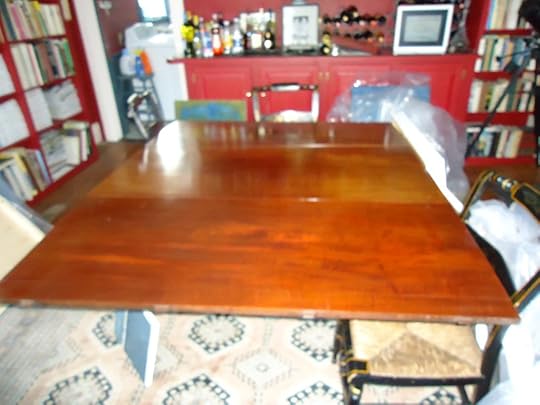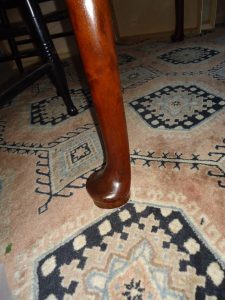The Meaning of a Dining Room Table
As many of you know, I am a fourth generation antique dealer.
I was taught, by example and explanation, to value possessions not only because they were functional, but because they had been well designed and crafted. That, for example, furniture made of “real wood” was more beautiful, and would last longer, than modern commercial versions. That, in fact, such furniture might be worth more in the future, whereas “used furniture” would be worth little or nothing.
When I began furnishing my own home, I did it by attending auctions, and antique shows. Occasionally I’d buy something at a department store sale, knowing it would have to be replaced in the future. But I’m still using most of the furnishings and accessories I bought when I was in my twenties. Every thing I bought meant something to me: a moment, a history, or a style. Everything was bought to last.
Like many young people, my funds were limited. I first lived in a Greenwich Village apartment, where there was little space. I slept on an inherited convertible couch and one table from Macy’s was my desk, dining and kitchen table.
When, as a new adoptive parent, I bought my first house, a small Victorian with adjoining living and dining rooms, I used both spaces as sitting (and playing) areas.
I was single. When I had friends visit, usually other single adoptive parents, our children played together, and we ate buffet-style, balancing plates of Chinese food or pizza on our laps. Being single in suburban New Jersey meant I was not invited to dinner parties — they were for married couples — and I didn’t give them.
Secretly. the idea of hosting an elegant dinner intimidated me. Family Thanksgivings and Christmases I could manage. But other than that, my entertaining was casual, comfortable – and informal.
When my family grew, and my mother came to live with me for most of the year, I bought a larger home. This home had a living room, dining room, and “family room” as well as a kitchen on the first floor. I dealt with it as I had my smaller home — I made the spaces separate, but informal, living areas. No dining room or dining room table. If I needed table space for a large gathering, I lined up card tables and covered them with table cloths.
And then, when I was in my mid-forties, and had just survived the break-up of a serious relationship, I had a revelation. In my mind, dining rooms (and dining room tables) were for married couples. Grown-ups. The sort of people who had large weddings and were gifted china and sterling silver place settings. (Or, in more recent times, stainless steel.)
Somehow people like that knew how to cook large elegant meals, and had the accoutrements to serve them. And other couples to invite to share them.
They were grownups.
I was a corporate manager, the mother of four and the grandmother of one. My mother, my children and my granddaughter all lived with me. But I finally admitted to myself that in some ways I was still waiting to be part of a grown up couple.
As a feminist, I was angry with myself for feeling that way. And I declared my independence by deciding that I would buy a dining room table.
Of course, I wanted to find the perfect table — one that would last, and fit my life and my home. For several months I visited furniture stores and department stores. Most of the tables I saw were not made well, and few would fit into my traditional home. I also discovered that a dinning room table was a major investment. I was a single mom. I didn’t have thousands of dollars to spend on a table. I was saving for my kids’ education and my retirement.
I gave up looking for my table.
That July I went to Maine on vacation. Since I was an antique print dealer, my mother and I (and various of my children) often visited antique shops. That year we visited the nearby shop of a high-end dealer whose family had one shop in London, one in Maine, and who did the major New York shows every winter. Although he specialized in seventeenth to early nineteenth century furniture, he occasionally found prints, and had called my mother to tell her he had a set of Cries of London. (A series of early 19th century hand colored engravings showing street sellers “crying” their goods in London.)

My table, as a circular table seating four.
While we were there, of course, I checked out the dining room tables. And I fell in love.
The table I admired was, the dealer told, me, one he’d just purchased from the Booth Tarkington estate in Maine. A writer’s dining room table! It was mahogany; Queen Anne style. And it was special for several reasons. It was three pieces — a small center piece, with two sides that would fold down, so the (then) oblong table could be put against a wall. And two semi-circles that fit together, making a table large enough to seat four. The half circles would also fit against a wall independently– or the entire table could be assembled and would easily seat ten to twelve.
Because of its versatility it would fit in either an apartment or a large home.

As a full table, leaves up, but without the semi-circular ends (that make up the round table.)
It was my table. Except for one thing. It cost four times as much as I had already determined to be too much to spend for a table. I admired it, drooled a little, and went home. (My mother and I did buy the Cries of London.)
Three days later I went back to visit the table. And then, a couple of days after that, I stopped in again. It haunted me. I dreamed about it.
And — a miracle happened. Each time I went back the dealer reduced the price to me. I didn’t even ask. He understood. And he knew I was a dealer. A single parent. A writer. And clearly I loved the table. But his price was still too high. The last week I was in Maine, visiting “my table” one last time, he threw up his hands. “It’s your table,” he declared. “I’ve had a good summer. I’ll take a tax loss on it if you can come up with … ” and he named the exact sum I had resisted paying for one of those modern tables I hadn’t liked.

Queen Anne legs …
I wrote a check on a line of credit for my antiques business. Two weeks later the table arrived in my New Jersey home. It is now in my home in Maine — part in the dining room, and part in the living room.
I never regretted it. That table was my proof to myself that I could be myself, successfully single, and grownup.
I’m not single anymore. And my husband and I do occasionally have dinner parties. It’s just as I had imagined. When we got married (at the town hall in Wiscasset with two witnesses) we decided to buy ourselves “wedding china” — which we did, piece by piece — so we now can serve guests in our own version of elegance.
Many books today suggest how to down size, and get rid of unwanted or unneeded possessions. Yes, we all have those.
But when you have the perfect table, it will stay. I hope I’ll live in this house for the rest of my life, but, if for some reason I don’t, that table will go with me.
It’s not just a table. It’s a symbol, of growing up, and accepting. And believing that what you really want and will work for, can be yours.



